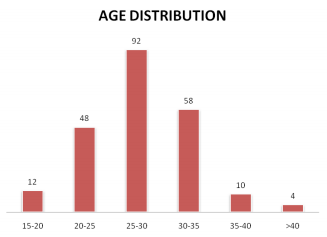Abstract
Objective: Anomaly scan at the second trimester provides
the detail anatomical study of fetus. Any structural or
morphological defects detected prenatally guides the
parents and doctors for further counseling. The main
objective of this study was to detect the fetal congenital
anomalies in high risk patients at 18-22 weeks and highlight
the effectiveness of prenatal ultrasound examination.
Materials and Methods: This was a hospital based
descriptive study done during the period of 2017
January to 2019 January in the department of Radiology,
ultrasound unit, Pokhara Academy of Health Sciences,
Nepal. Pregnant women who were first examined and
evaluated by the Obstetrician during the ante-natal check
up (ANC) either by asking the patient history or by mother
age or any symptoms or chance of being abnormalities
or high risk patients during that time frame (18-22
weeks) were enrolled for the study. Maternal age, parity,
any history of previous anomalies, previous history of
miscarriage/Intra Uterine Fetal Demise ( IUFD) or any
exposure to radiation or drugs, history of other disease
were recorded during the filling of consent form. High risk
patients were identified by the Obstetrician and anomaly
examination was prescribed at second trimester (18-20
weeks). Descriptive analysis was done using SPSS 20.
Results: There were two hundred and twenty four patients
who had undergone anomaly (targeted fetal anatomy)
examination which were referred for “anomaly scan” from
the gynecology and obstetrics department during that period.
Among all the cases, fourteen cases had anomalies detected
during the scan (18-22 weeks). Out of which seven cases
had central nervous system related anomalies, two cases
had skeletal deformities (dysplasia), two case had urinary
tract related anomalies, one had lungs related anomalies
and one had single umbilical artery with polyhydroamnios
associated with duodenal atresia and one case had
malformation of lymphatic system ( cystic hygroma )
Conclusion:Our study revealed that ultrasound scan
performed between 18-22 weeks of pregnancy is
effective in diagnosing major fetal abnormalities in the
high-risk patients.
References
scan (7+3=10): A rational approach (including the “rule
of three”). J Fetal Med 2014; 1:59-73.
2. Premnath KPB, Joy B, Toms A, Sleeba T. Image
Acquisition Adequacy for Second Trimester Targeted
Fetal Scans - A Clinical Audit. Int J Sci Stud 2017;
5(3):57-60.
3. Dastgiri S, Stone DH, Le-Ha C, Gilmour WH.
Prevalence and secular trend of congenital anomalies in
Glasgow, UK. Arch Dis Child. 2002; 86:257–63
4. Akinmoladun JA, Ogbole GI, Lawal TA, Adesina OA.
Routine prenatal ultrasound anomaly screening program
in a Nigerian university hospital: Redefining obstetrics
practice in a developing African country. Niger Med J.
2015;56(4):263-67.
5. WHO South East Asia Regional Neonatal-Perinatal
Database Report 2007-2008. Available from http://
ghdx.healthdata.org/record/who-south-east-asia-
regional-neonatal-perinatal-database-report-2007-2008.
Accessed July 7 2019.
6. Syngelaki A, Chelemen T, Dagklis T, Allan L,
Nicolaides KH. Challenges in the diagnosis of fetal non-
chromosomal abnormalities at 11– 13 weeks. Prenatal
Diagnosis. 2011;31(1):90- 102.
7. Srisupundit K, TheeraTongsong T, Sirichotiyakul S,
Chanprapaph P. Fetal structural anomaly screening at
11-14 weeks of gestation at Maharaj Nakorn Chiang Mai
Hospital. J Med Assoc Thai. 2006; 89(5):588-93.
8. Ewigman BG, Crane JP, Frigoletto FD, LeFevre ML,
Bain RP, McNellis D. Effect of prenatal ultrasound
screening on perinatal outcome. RADIUS Study
Group. N Engl J Med. 1993;329:821–27.
9. Grandjean H, Larroque D, Levi S. The performance of
routine ultrasonographic screening of pregnancies in the
Eurofetus Study. Am J Obstet Gynecol. 1999;181(2):446–54.
10.Salomon LJ, Alfirevic Z, Berghella V, Bilardo C,
Hernandez-Andrade E, Johnsen SL, et al. Practice
guidelines for performance of the routine mid-
trimester fetal ultrasound scan. Ultrasound Obstet
Gynecol. 2011;37(1):116–26.
11. Nakling J, Backe B. Routine ultrasound screening
and detection of congenital anomalies outside a
university setting. Acta Obstet Gynecol Scand. 2005;
84(11):1042–48.
12. Nikkilä A, Rydhstroem H, Källén B, Jörgensen C.
Ultrasound screening for fetal anomalies in southern
Sweden: A population-based study. Acta Obstet Gynecol
Scand. 2006; 85(6):688–93.
13.Shrestha S, Dwa Y, Jaiswal P & Parmar B. Congenital
anomalies in antenatal ultrasound scan at a tertiary care
teaching hospital. Journal of Patan Academy of Health
Sciences. 2018; 5(1):26-30
14.Kashyap N, Pradhan M, Singh N, Yadav S. Early
Detection of Fetal Malformation, a Long Distance Yet
to Cover! Present Status and Potential of First Trimester
Ultrasonography in Detection of Fetal Congenital
Malformation in a Developing Country: Experience
at a Tertiary Care Centre in India. J Pregnancy. 2015;
2015:623059
15. Malla BK One year review study of congenital
anatomical malformation at birth in Maternity Hospital
(Prasutigriha), Thapathali, Kathmandu. Kathmandu
Univ Med J. 2007; 5(4):557-60.
16. Akinmoladun JA, Ogbole GI, Lawal TA, Adesina OA.
Routine prenatal ultrasound anomaly screening program
in a Nigerian university hospital: Redefining obstetrics
practice in a developing African country. Niger Med J.
2015; 56(4):263–67.
17. De-Regil LM, Peña-Rosas JP, Fernández-Gaxiola AC,
Rayco-Solon P.Effects and safety of periconceptional
oral folate supplementation for preventing birth defects.
Cochrane Database of Systematic Reviews 2015, 12:
CD007950.
18. Birth Defects In South-east Asia A Public Health
Challenge Situation Analysis WHO 2013;2(1):75
19.Sugunbai NS, Mary M, Shymalan K, Nair PM.
An etiological study of congenital malformations in
newborns. Indian Pediatr. 1982; 19:1003-09.
20. Mohanty C, Mishra OP, Das BK, Bhatia BD,
Singh G. Congenital malformations in newborns:
A study of 10,874 consecutive births. J Anat Soc
India. 1989;38:101–11.

